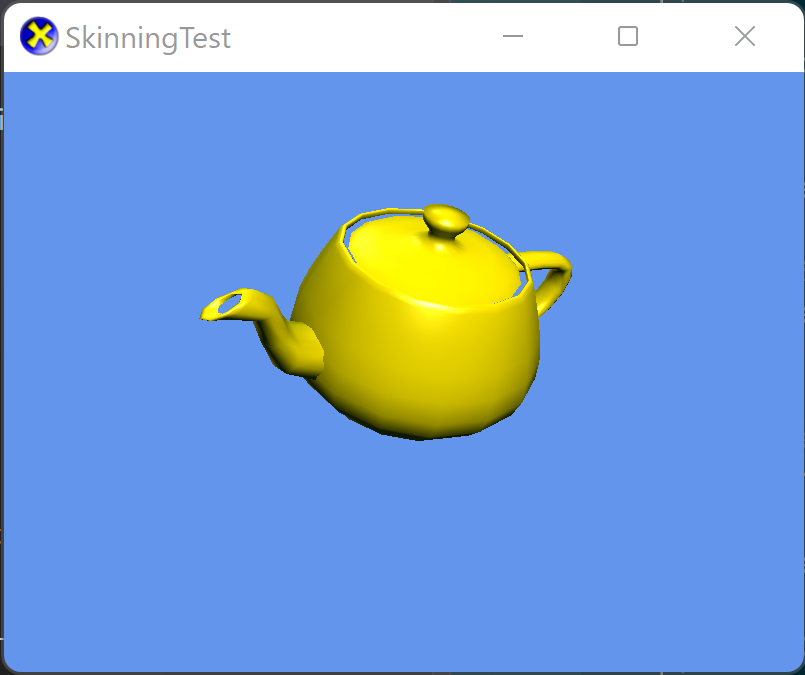-
Notifications
You must be signed in to change notification settings - Fork 513
Using skinned models
In this lesson we learn how to render models using skinned vertices for smooth animations.
First create a new project using the instructions from the previous lessons: Using DeviceResources and Adding the DirectX Tool Kit which we will use for this lesson.
In the previous lesson, we learned the use of ModelBone as general metadata and for doing rigid-body animation of meshes. The other common use for model bones is as a 'skeleton' to control vertices for vertex skinning animation.
Like XNA Game Studio, the DirectX Tool Kit does not provide a specific implementation of an animation control system. There are numerous approaches, and each have their own strengths and weaknesses. In this lesson, we'll cover the animation system in the Visual Studio Mesh Content Pipeline (CMO) and the legacy DirectX SDK sample animation system (SDKMESH v1), providing some basic code for using them. Neither solution is ideal, but they do a good job of demonstrating the techniques and some trade-offs.
Start by saving teapot.cmo into your new project's directory, and then from the top menu select Project / Add Existing Item.... Select "teapot.cmo" and click "OK".
If you are using a Universal Windows Platform app or Xbox project rather than a Windows desktop app, you need to manually edit the Visual Studio project properties on the
teapot.cmofile and make sure "Content" is set to "Yes" so the data file will be included in your packaged build.
Now download Animation.cpp and Animation.h into your project directory. Use Project / Add Existing Item... to add them to your project. This is a simple helper class we'll describe more later on in the lesson.
In the Game.h file, add to the list of header includes:
#include "Animation.h"In the Game.h file, add the following variables to the bottom of the Game class's private declarations:
DirectX::SimpleMath::Matrix m_world;
DirectX::SimpleMath::Matrix m_view;
DirectX::SimpleMath::Matrix m_proj;
std::unique_ptr<DirectX::CommonStates> m_states;
std::unique_ptr<DirectX::IEffectFactory> m_fxFactory;
std::unique_ptr<DirectX::Model> m_model;
DirectX::ModelBone::TransformArray m_drawBones;
DX::AnimationCMO m_animation;In Game.cpp, add to the TODO of CreateDeviceDependentResources:
m_states = std::make_unique<CommonStates>(device);
m_fxFactory = std::make_unique<EffectFactory>(device);
size_t animsOffset;
m_model = Model::CreateFromCMO(device, L"teapot.cmo",
*m_fxFactory,
ModelLoader_CounterClockwise | ModelLoader_IncludeBones,
&animsOffset);
DX::ThrowIfFailed(
m_animation.Load(L"teapot.cmo", animsOffset)
);
m_animation.Bind(*m_model);
m_drawBones = ModelBone::MakeArray(m_model->bones.size());
m_model->UpdateEffects([&](IEffect* effect)
{
auto skin = dynamic_cast<SkinnedEffect*>(effect);
if (skin)
{
skin->SetPerPixelLighting(true);
}
});
m_world = Matrix::Identity;In Game.cpp, add to the TODO of CreateWindowSizeDependentResources:
static const XMVECTORF32 c_cameraPos = { 100.f, 100.f, 200.f, 0.f };
static const XMVECTORF32 c_lookAt = { 0.f, 25.f, 0.f, 0.f };
auto size = m_deviceResources->GetOutputSize();
m_view = Matrix::CreateLookAt(c_cameraPos.v, c_lookAt.v, Vector3::UnitY);
m_proj = Matrix::CreatePerspectiveFieldOfView(XM_PI / 4.f,
float(size.right) / float(size.bottom), 0.1f, 1000.f);In Game.cpp, add to the TODO of OnDeviceLost:
m_states.reset();
m_fxFactory.reset();
m_model.reset();In Game.cpp, add to the TODO of Render:
size_t nbones = m_model->bones.size();
m_animation.Apply(*m_model, nbones, m_drawBones.get());
m_model->DrawSkinned(context, *m_states, nbones, m_drawBones.get(),
m_world, m_view, m_proj);In Game.cpp, add to the TODO of Update:
float time = float(timer.GetTotalSeconds());
m_world = XMMatrixRotationY(time);Build and render to see a dancing teapot:
Most of the 'magic' here is taking place inside AnimationCMO, so here's an explanation of what's happening.
-
When loading the
CMO, we provide theanimsOffsetoptional parameter which provides the offset to the start of the animation clip or clips inside theCMOfile. -
We call the Load method on the
AnimationCMOclass which takes theanimsOffsetto simplify parsing. It then loads the animation data contained in theCMOfile in the form of keys and 4x4 matrices:
struct Clip
{
float StartTime;
float EndTime;
uint32_t keys;
};
struct Keyframe
{
uint32_t BoneIndex;
float Time;
DirectX::XMFLOAT4X4 Transform;
};Because
CMOfiles can contain multiple clips, the Load method takes a defaulted parameter for the name of the clip. Our test file here just has one.
-
The call to the Bind method for CMO animation just allocates a
ModelBone::TransformArray(calledm_animBonesbelow). -
We call the Update method to compute the current animation time. In the case of
CMOanimation, we also force looping behavior for simplicity. -
Before we can draw the model, we then call Apply with the results returned in the
boneTransformsparameter. This takes the current animation time and determines each model bone transformation from theKeyframedata. Then it callsModel::CopyAbsoluteBoneTransformsto evaluate the bone hierarchy. Finally it multiplies the results by the "Inverse Bind Pose" for each bone:
// Compute local bone transforms
model.CopyBoneTransformsTo(nbones, m_animBones.get());
// Apply keyframes
if (m_animTime >= m_startTime)
{
size_t k = 0;
for (auto kit : m_keys)
{
if (kit.second > m_animTime)
{
break;
}
m_animBones[kit.first] = m_transforms[k];
++k;
}
}
// Compute absolute locations
model.CopyAbsoluteBoneTransforms(nbones, m_animBones.get(),
boneTransforms);
// Adjust for model's bind pose.
for (size_t j = 0; j < nbones; ++j)
{
boneTransforms[j] = XMMatrixMultiply(model.invBindPoseMatrices[j],
boneTransforms[j]);
}The 'bind pose' is the 'starting position' of the model on which the animations are based.
- Finally, we draw the model using the
Model::DrawSkinnedmethod with the computed bone transform matrices.
Now save soldier.sdkmesh, soldier.sdkmesh_anim, head_diff.dds, head_norm.dds, jacket_diff.dds, jacket_norm.dds, pants_diff.dds, pants_norm.dds, upBody_diff.dds, and upbody_norm.dds into your new project's directory. From the top menu select Project / Add Existing Item..., then select "soldier.sdkmesh", "soldier.sdkmesh_anim", and the eight DDS files followed by "OK".
If you are using a Universal Windows Platform app or Xbox project rather than a Windows desktop app, you need to manually edit the Visual Studio project properties on the
soldier.sdkmeshandsoldier.sdkmesh_animfiles and make sure "Content" is set to "Yes" so the data file will be included in your packaged build.
UNDER CONSTRUCTION
- Vertex skinning is supported by SkinnedEffect, SkinnedNormalMapEffect, SkinnedPBREffect, and SkinnedDGSLEffect using the
IEffectSkinninginterface.
Next lesson: Using advanced shaders
All content and source code for this package are subject to the terms of the MIT License.
This project has adopted the Microsoft Open Source Code of Conduct. For more information see the Code of Conduct FAQ or contact [email protected] with any additional questions or comments.
- Universal Windows Platform apps
- Windows desktop apps
- Windows 11
- Windows 10
- Windows 8.1
- Xbox One
- x86
- x64
- ARM64
- Visual Studio 2022
- Visual Studio 2019 (16.11)
- clang/LLVM v12 - v18
- MinGW 12.2, 13.2
- CMake 3.20
